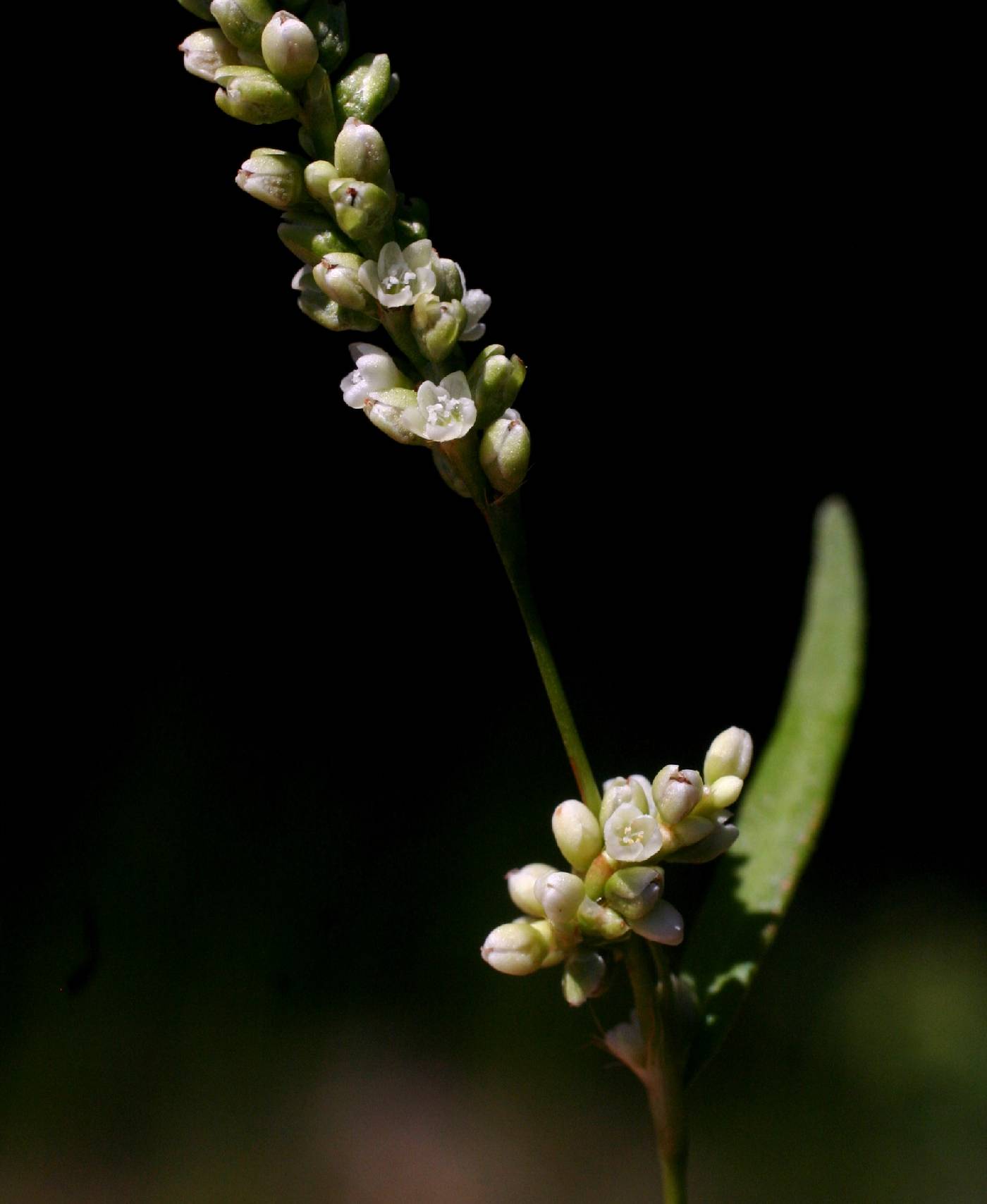Plants perennial, 1.5-10 dm; roots also often arising from proximal nodes; rhizomes often present. Stems decumbent to ascending, usually branched, without noticeable ribs, glabrous or obscurely strigose distally. Leaves: ocrea brown, cylindric, 5-23 mm, chartaceous, base inflated, margins truncate, ciliate with bristles (2-)4-10 mm, surface glabrous or strigose, not glandular-punctate; petiole 0.2-2 cm, glabrous or strigose; blade without dark triangular or lunate blotch adaxially, broadly lanceolate to linear-lanceolate, 5-25 × 0.4-3.7 cm, base tapered or acute, margins antrorsely appressed-pubescent, apex acuminate, faces glabrous or appressed-pubescent along midveins and sometimes on faces, usually punctate abaxially. Inflorescences terminal, sometimes also axillary, erect, uninterrupted or interrupted proximally, 30-80 × 2-5 mm; peduncle 10-30 mm, glabrous or strigose; ocreolae overlapping distally, often not overlapping proximally, margins ciliate with bristles to 2(-3) mm. Pedicels ascending, 1-1.5 mm. Flowers bisexual or unisexual and staminate, 2-6 per ocreate fascicle, homostylous; perianth roseate proximally, roseate, white, or greenish white distally, not glandular-punctate or sometimes glandular-punctate with punctae on tubes and inner tepals, scarcely accrescent; tepals 5, connate ca. 1/ 1/ 2 their length, obovate, 2.5-4 mm in bisexual flowers, 1.5-2.5 mm in staminate flowers, veins prominent or not, not anchor-shaped, margins entire, apex obtuse to rounded; stamens 8, included or exserted in staminate flowers; anthers pink or red, elliptic to ovate; styles 3, connate near middle. Achenes included or apex exserted, brown to brownish black or black, 3-gonous, 1.5-3 × 1-2.3 mm, shiny, smooth.
Flowering Jun-Nov. Wet banks and clearings, shallow water, marshes, moist prairies, ditches; 0-1500 m; B.C., N.B., N.S., Ont., Que.; Ala., Alaska, Ariz., Ark., Calif., Conn., Del., D.C., Fla., Ga., Idaho, Ill., Ind., Iowa, Kans., Ky., La., Maine, Md., Mass., Mich., Minn., Miss., Mo., Nebr., N.H., N.J., N.Y., N.C., N.Dak., Ohio, Okla., Oreg., Pa., R.I., S.C., S.Dak., Tenn., Tex., Vt., Va., Wash., W.Va., Wis.; Mexico; Central America; South America.
The extreme variability in Persicaria hydropiperoides is reflected in its extensive synonymy. Among the segregates most often recognized in floras and checklists is P. opelousana, which C. B. McDonald (1980) showed to be broadly sympatric and highly interfertile with P. hydropiperoides. Consistent with this conclusion, R. S. Mitchell (1971) found that P. hydropiperoides and P. opelousana are unique among native North American smartweeds in consistently possessing multicellular plate-glands on the abaxial surface of their leaves. Such glands also are found on P. maculosa, an introduced European species.
Herbarium specimens of Persicaria hydropiperoides sometimes are misidentified as P. maculosa, especially when the roots are missing. The former species may be distinguished reliably by its achenes all trigonous (trigonous and biconvex achenes are mixed in the inflorescences of P. maculosa) and bristles on the margins of the ocreae that average longer. M. L. Fernald (1922c) reported hybrids with P. robustior from Nova Scotia.
Frequent throughout the state in dried-up ponds and sloughs, in wet ground along streams and about lakes, and in marshes and ditches. [Variety strigosum] was reported from Indiana by Small. It is separated from the species by having a strigose-pubescent stem. The stems of the specimens at hand vary from glabrous below the nodes to densely strigose for a third of the length of the internode. One branch of a specimen may have all of the internodes glabrous and another have some of the internodes strigose below the nodes. Since a close lineal series from glabrous to densely strigose can be found, I prefer to say that the species varies from glabrous to densely strigose.
Duration: Perennial
Nativity: Native
Lifeform: Forb/Herb
General: Annual to perennial from creeping rootstocks, herbage glabrous to pubescent, stems decumbent to nearly erect, sometimes rooting at jointed and swollen nodes, sometimes branched above, to 2 m long.
Leaves: Simple, alternate, lanceolate to oblong-lanceolate to 25 cm long and 6 cm wide, acute to acuminate at the apex, with ocrea 10-20 mm long, strigose, bristly ciliate.
Flowers: Spikelike, often in interrupted racemes, perianth of 4 or 5 segments, calyx glabrous, without glands, green, white or pinkish, about 3 mm long, 8 stamens.
Fruits: Achenes, 3-angled, 2.5-3 mm long, lustrous dark brown.
Ecology: Found in marshy or wet ground along streams, lands, or ponds from 4,000-7,000 ft (1219-2134 m); flowers June-October.
Notes: Can be distinguished by the ocrea with marginal cilia that is at least 3 mm long, the inflorescence also tapers to an apex and is generally longer than most other species. Note the recent name change from Polygonum to Persicaria.
Ethnobotany: Unknown
Etymology: Polygonum is derived from Greek polys, many, and gonu, knee or joint, while hydropiperoides means like or having a resemblance to hydropiper, which comes for hydro for water and piper for pepper.
Synonyms: Polygonum hydropiperoides, see Tropicos
Editor: SBuckley, 2010
Rhizomatous perennial, erect or ascending, to 1 m; lvs lanceolate to linear; ocreae always strigose and ciliate; peduncles usually strigose, especially above; racemes slender, erect, often interrupted below; ocreolae separate or scarcely overlapping, obconic, usually short-ciliate; perianth white, greenish, or pink, conspicuously exsert; achenes ovoid, black, smooth and shining, trigonous with rounded angles and concave sides, 1.8-3 mm; 2n=20, 40. Wet soil, beaches, marshes, and shallow water; Que. to B.C., s. to S. Amer. Highly variable, and divisible into 3 vars.:
Gleason, Henry A. & Cronquist, Arthur J. 1991. Manual of vascular plants of northeastern United States and adjacent Canada. lxxv + 910 pp.
©The New York Botanical Garden. All rights reserved. Used by permission.







